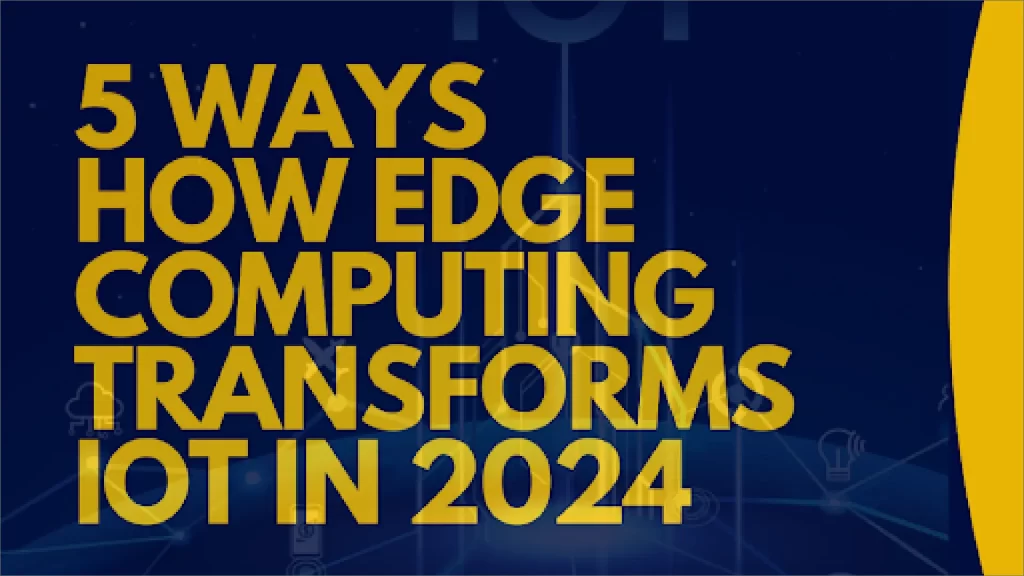5 Ways How Edge Computing Transforms IoT in 2024

Edge computing is making big changes to the Internet of Things (IoT), making it faster, smarter, and more useful.
Ways How Edge Computing Transforms In IoT
Here are five main ways that this change is taking place:
1. Real-Time Data Processing and Analysis
Edge computing lets IoT devices handle data closer to where it’s made instead of moving it over long distances to data centers or clouds. This means that data can be analyzed and processed in real time. This cuts down on delay, which speeds up data and decision-making in real time. In manufacturing, for example, instant data analysis can find problems with machines and lead to quick fixes, which avoids costly downtimes.
Edge computing is a key part of making the shopping experience better for customers and increasing sales in busy stores. IoT devices, such as cameras and sensors, track customers as they move through the store and record information about their shopping habits, likes, and dislikes. Edge computing lets all of this raw data be processed right at the shop, instead of sending it to a faraway data center. In real time, the store can send unique deals, discounts, and sales straight to the customer’s smartphone.
For example, if a customer stays in the electronics area for a long time looking at laptops, the system can quickly figure out what they’re doing and give them a special deal on laptops or devices, which will make them more likely to buy right away and make the customer happier.
2. Bandwidth Optimization
Only the processed, useful data needs to be sent to the central computers when data is handled locally at the edge. This cuts down on the speed needed and keeps the network from getting clogged up with a lot of raw data. This is especially helpful in situations where connection might be slow or cost a lot, like when oil rigs are being watched from afar.
Ships at sea have a lot of monitors and Internet of Things (IoT) devices that collect data on everything from the state of the goods to how well the engines are running and the weather. Sending this much data to a central computer by satellite uses a lot of bandwidth and costs a lot of money. Edge computing lets data be handled right on the ship, where it can be analyzed and boiled down into useful information and important updates.
Only this important information is sent back to the team onshore, which cuts down on broadband use and prices by a large amount. This makes sure that ship operations are always being watched over and improved, even though connection at sea is limited and expensive.
3. Enhanced Security and Privacy
Edge computing can make IoT devices safer and more private. Sensitive data doesn’t have to be sent over the network to a central cloud when data is processed locally. This makes it less vulnerable to leaks. Edge devices can also use local encryption and other security measures to keep data safe where it’s being collected.
Every day, financial institutions deal with very private personal and business data. Edge computing is a strong way to make data more private and secure. In a local office of a bank, for example, ATMs and computers can handle activities without having to send data across the network to a central data center. The chance of data being stolen while in transit is lower because of this.
To make sure that customers’ financial information is kept safe, local processing can include encryption, abnormal detection, and instant scam alerts. This keeps the customer’s information safe and helps the business stay in line with the rules and keep the trust of its customers.
4. Improved Reliability and Resilience
Edge computing spreads data processing across many edge devices, making them less reliant on a central server. This makes the system more reliable and resilient. This means that the system can keep working even if one device breaks or a link is lost. This gives it a higher level of uptime and stability. This tool can save lives in important situations like tracking healthcare or self-driving cars.
Sensors and Internet of Things (IoT) devices keep an eye on things like weather, plant health, soil wetness, and more in a smart farm. These tools are very important for making quick choices like when to water or feed plants. With edge computing, the data from these devices is handled close to where they are used. This way, if one monitor stops working or loses its network link, the others can still do their jobs.
With this autonomous method, actions and tracking don’t stop, so you can always keep an eye on how the crops are doing. This can make crops healthier, increase output, and make better use of resources, all of which are very important in modern precision agriculture.
5. Scalability and Flexibility
Edge computing makes IoT systems more scalable and adaptable. It’s easy for edge computing platforms to handle more devices because they don’t need to send all of their data back to a central place. This flexibility makes sure that the system can grow and change without major problems as more IoT devices are added to smart towns, factories, and our homes.
As towns get smarter and better connected, more and more Internet of Things (IoT) gadgets are being used to keep an eye on things like traffic, energy use, public safety, and more. Managing the info from all of these gadgets in one place can slow things down and waste time. Edge computing is a system that can be expanded and changed as needed.
For example, traffic management systems can use data from cameras and sensors at crossings to make decisions in real time, like changing the patterns of traffic lights during rush hour to make things run more smoothly. Edge computer nodes are easy to add to the system as the city grows and more devices are added. This way, the system stays fast and useful without putting too much stress on the core resources. This flexible method is necessary for a smart city, which is always changing and growing.
Bottom Line
To sum up, edge computing makes IoT systems much more useful by allowing faster processing, lowering bandwidth, boosting security, making systems more reliable, and offering solutions that can be scaled up or down. Edge computing and the Internet of Things (IoT) are expected to work together better as technology keeps getting better, leading to more innovations and better ways of doing things.
Read More: What is a High Perplexity Score in GPT Zero?



